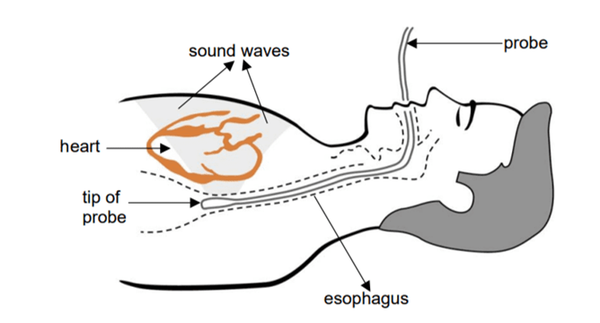Transoesophgeal echocardiogram (TOE)
Introduction
A transoesophageal echocardiogram is an ultrasound test that uses sound waves to produce moving real-time pictures of your heart. An ultrasound probe is passed down your oesophagus (the tube that goes from your mouth to your stomach) to take images from inside your body.
It gives more detailed pictures of your heart than a standard transthoracic echocardiogram. A transthoracic echocardiogram is an external ultrasound test that produces pictures of your heart by placing the probe over your chest.
What is a transoesophageal echocardiogram?
A transoesophageal echocardiogram (TOE) shows the structures of your heart and how well they work. The ultrasound probe is put down your throat so that it’s very near your heart. The ultrasound pictures are then shown on the screen.
This test can check for lots of different things to do with your heart. It can show:
- Problems with your heart valves
- Blood clots within your heart
- Problems with your aorta (the main artery that carries blood away from your heart)
- Areas where heart muscle isn’t working properly because of a heart attack
A surgeon can also use it as a guide if you’re having an operation on your heart.
Preparing for transoesophageal echocardiogram
A TOE is usually done as a day-case procedure in hospital. This means you have the test and go home the same day.
The cardiologist or the sonographer will explain how to prepare for your procedure. You will be asked not to eat or drink anything for about six hours beforehand. If you’re taking any medicines, you’ll be fine to do so on the morning of your appointment with a sip of water. You can drink water only, upto 2 hours prior to the procedure.
You’ll stay awake during the procedure although the doctor will give you a sedative. This relieves anxiety and will help you to relax.
You’ll be asked to sign a form to give your consent for the transoesophageal echocardiogram to go ahead.
What happens during transoesophageal echocardiogram
The TOE procedure itself usually takes about 20 minutes, but we leave 1 hour for the appointment and preparation as well as recovery.
You’ll need to undress down to the waist and put on a hospital gown. You’ll also need to remove dentures or dental plates if you have them.
You will have ECG stickers put on your chest to monitor the rhythm of your heart throughout the test, a blood pressure cuff on one of your arms to check your blood pressure at specific intervals and a small probe on one of your fingers to monitor the percentage of blood oxygen. You’ll be given oxygen into your nose to help your breathing while the probe is into your throat.
As you are having a sedative, you’ll have a fine plastic tube (called cannula) put into a vein in your arm or the back of your hand.
The doctor will spray a local anaesthetic into the back of your throat to numb it, and then ask you to lie on your left side. The ultrasound probe will be placed into your mouth and the doctor will ask you to swallow the probe so the probe can pass into your oesophagus. The test isn’t painful but it may feel uncomfortable when the probe passes down the back of your throat. You’ll still be able to breath normally throughout.
The probe will send out sound waves and pick up the returning echoes, which are converted into pictures of the inside of your heart. These are displayed on a monitor and are constantly updated so the scan can show movement.
You’ll need to rest until the effects of the sedative have worn off. You can wait in the hospital waiting area until you feel ready to go home. It is fundamental for you to have a relative or friend to drive you home.
After a local anaesthetic, it can take a while for the feeling to come back into your mouth and throat. You therefore can’t drink or eat anything for about two hours after the test (follow the instruction on the ‘Post-procedure leaflet’ you’ll be given before you leave the procedure room).
The final result will be sent to your referring doctor who will go through them with you at your next appointment.
Recovering from transoesophageal echocardiogram
Having a sedative can make you feel sleepy. You might find you’re not as coordinated as usual or that it’s difficult to think clearly. This should pass within 24 hours. In the meantime, don’t drive, drink alcohol, operate machinery or sign anything important.
You can go back to your usual activities the day after your procedure because the effects of the sedative will have worn off by then.
Side-effects of transoesophageal echocardiogram
Side-effects are mostly temporary effects that you may have after the procedure.
You may have a sore throat for a day or two after the TOE.
Complications of transoesophageal echocardiogram
Complications are when problems occur during or after the procedure. Complications of a transoesophageal echocardiogram can include:
- An allergic reaction to the sedative – such as breathing difficulties or feeling sick
- Inhaling the contents of your stomach – this shouldn’t happen if you stop eating and drinking before the procedure, and don’t suffer with gastroparesis.
- A very small risk of damage or a tear to your oesophagus
- Risk of damage for your teeth or back of your mouth
Contact information:
If you have any questions about your planned Transoesophageal echocardiogram, please contact (Monday to Friday, 9:00am to 4:30pm):
Diagnostic Cardiology – ECG Department (Chelsea and Westminster Hospital)
Tel: 020 33153443 / 5
Diagnostic Cardiology – ECG and ECHO Department (West Middlesex University Hospital)
Tel: 020 8560 5336
This leaflet was written by:
Teresa Rutigliano (Senior Chief Cardiac Physiologist)
Reviewed and approved by:
Dr G Sunthar Kanaganayagam
Consultant Cardiologist and Cardiology Imaging Lead

